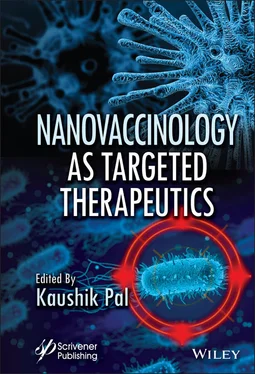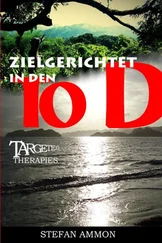Nanovaccinology as Targeted Therapeutics
Здесь есть возможность читать онлайн «Nanovaccinology as Targeted Therapeutics» — ознакомительный отрывок электронной книги совершенно бесплатно, а после прочтения отрывка купить полную версию. В некоторых случаях можно слушать аудио, скачать через торрент в формате fb2 и присутствует краткое содержание. Жанр: unrecognised, на английском языке. Описание произведения, (предисловие) а так же отзывы посетителей доступны на портале библиотеки ЛибКат.
- Название:Nanovaccinology as Targeted Therapeutics
- Автор:
- Жанр:
- Год:неизвестен
- ISBN:нет данных
- Рейтинг книги:3 / 5. Голосов: 1
-
Избранное:Добавить в избранное
- Отзывы:
-
Ваша оценка:
- 60
- 1
- 2
- 3
- 4
- 5
Nanovaccinology as Targeted Therapeutics: краткое содержание, описание и аннотация
Предлагаем к чтению аннотацию, описание, краткое содержание или предисловие (зависит от того, что написал сам автор книги «Nanovaccinology as Targeted Therapeutics»). Если вы не нашли необходимую информацию о книге — напишите в комментариях, мы постараемся отыскать её.
Nanovaccinology as Targeted Therapeutics
Nanovaccinology as Targeted Therapeutics — читать онлайн ознакомительный отрывок
Ниже представлен текст книги, разбитый по страницам. Система сохранения места последней прочитанной страницы, позволяет с удобством читать онлайн бесплатно книгу «Nanovaccinology as Targeted Therapeutics», без необходимости каждый раз заново искать на чём Вы остановились. Поставьте закладку, и сможете в любой момент перейти на страницу, на которой закончили чтение.
Интервал:
Закладка:
1.4.5 Virus-Like Particles
Another biomolecular NPs known as VLP has a typical virus shape but lacks viral genome, rendering them inactive and unable of replication. They quickly and effectively produce a strong and prolong immunological response in the host [79]. Hepatitis B protection is provided first with a VLP-based human vaccination[80]. VLPs have recently been used as vehicles for several human papillomavirus (HPV) vaccines. According to a recent study, HPV vaccinations based on VLPs elicit a strong cross-protective antibody response [81]. During chronic infection, cytotoxic T cells are essential for removing damaged cells and regulating microbe load. They can really be highly effective in vaccines because they target the T-cell response.
1.4.6 Micelles
The cores of micelles, another type of biomolecular NPs, are hydrophobic in contrast to liposomes and VLPs [82]. They are widely used with weakly water-soluble drugs delivery or encapsulated amphiphilic compounds [83]. Micelles have been used in two different ways as vaccine delivery systems. First, protein vaccines may be simply covalently attached to the hydrophilic micelle. HIV vaccines have been attached to adjuvant-loaded micelles using this approach, resulting in significant APC activation in vitro [84]. Model peptide antigens coupled to polymer-lipid microspheres are demonstrated to attach protein albumin and travel to the lymphatic vessels, where they significantly raise T-cell numbers and act as an anticancer vaccination [85]. Endosome disruption can be triggered by polymer-based micelles, allowing vaccines to be transported to the cytoplasm, resulting in significant cytotoxic T-cell responses [86]. Molecules with similar or identical hydrophobic moieties can also be self-assembled and form heterogeneous micelles. This phenomenon has been utilized to create protein amphiphile microspheres capable of transporting several antigens to the same cell [87].
1.4.7 Immunostimulating Complexes
ISCOMs are biomolecular structures. They are made up of cholesterols, phospholipids, and Quil A saponins. ISCOMs have an immunostimulatory effect because they contain Quil A saponins, which are well-known adjuvants. ISCOMs have been studied for around 35 years to be highly effective as a synthetic vaccine [88]. Still, they can cause significant, unfavorable injection-site reactions [89], limiting their use to animal vaccinations [90]. ISCOMA-TRIX is identical to the traditional ISCOM except that the Quil A saponins are first filtered to give a specified group of saponins that do not induce substantial inflammation [91]. ISCOMA-TRIX has been demonstrated to produce immune responses in mice and rabbits [92].
1.4.8 Self-Assembled Proteins (SAPNs)
SAPNs are 20–30 nm icosahedrons. For the manufacture of NPs-based vaccinations, self-assembling technologies promote higher levels of protein quaternary structure. By genetic engineering technique, attaching the influenza virus with ferrintin, researchers could generate a stronger immunological response than the flu vaccine [93]. Another protein is the major vault protein (MVP). For studies of mucosal immunity, Vault NPs are utilized [94]. SAPNs have been shown to improve immunity in a various of diseases, including malaria [95], HIV [96], toxoplasma [97], and severe acute respiratory syndrome [98]. Then encapsulate two HIV protein epitopes onto SAPN surface produce epitope-specific neutralizing antibodies more efficiently. This suggests that SAPN could be used as a nanovaccine to trigger an immunological response against HIV [96].
1.4.9 Emulsions
Nano-sized emulsions are another type of NPs used as an adjuvant in vaccinations [99–101]. These NPs can be found with sizes ranging from 50 to 600 nm. It can either contain antigens in their core for optimal vaccination administration or be combined with the antigen [101]. MF59TM, an oil-in-water emulsion, which has been approved as a safe and effective vaccine adjuvant [102, 103], is one of the most regularly used emulsions. It has been undergone extensive research for application in influenza vaccines [103–105]. Another example is Montanide ™that has been used in Malaria vaccines [106, 107] and vaccines for foot-and-mouth disease [108]. Noncovalent click self-assembly has been used to produce a tailorable nanosized emulsion platform technology for antigen and medication delivery [109].
1.5 Constraints and Challenges of Nanovaccines
A successful vaccine requires a solid understanding of the physiological and immunological characteristics of any disease. Nanovaccines are widely using for treating numerous infectious and non-infectious diseases; their efficiency in stimulating our immune response to infections may be expected to be more significant. Understanding the properties of NPs and how they interact with cells can help to develop safer nanovaccines. NPs have toxicity, which must be addressed judiciously to maximize their utilization. The toxic effects and immunological responses generated by NPs are influenced by their composition, size, charge, shape, hydrophobicity, and route of exposure. NPs cause cellular injury in a size-dependent manner because smaller nanoparticles are more active, they can do more damage. NPs can easily penetrate alveoli, where they can aggregate and cause pulmonary inflammation [110, 111]. On the other hand, repetitive exposure to NPs damages the lung cells, allowing them to penetrate blood vessels and travel from lung tissue to other organs via systemic circulation. The shape of NPs plays a role in their toxicity; for example, nanofibers are shown to be more cytotoxic than spherical NPs of the same composition [112]. NPs with a low solubility or disintegration rate accumulate in cells and tissues, where they persist for a long time, such as rat nasal exposure to Au NPs lasted 15 days. Ag NPs aggregates accumulated in the lungs for 7 days [113]. NPs that penetrate the cell can increase the reactive oxygen species (ROS). The accumulating ROS interacts with the protein machinery of cell, affecting all metabolic activities in the cell. They also exhibit mitochondrial toxicity and nuclear DNA damage. Apoptosis occurs when a cell is exposed in this way [114]. As a result, high concentrations of NPs or their accumulation cause disturbance of cellular homeostasis. It can be concluded that NPs may cause tissue damage, resulting in local and systemic pathophysiological disorders. Some of the drawbacks of nanovaccines are related to their stability [115]. Increased production of nanovaccines is also an important concern due to their activity and cost-effective manufacturing process. Several loading of various components, such as antigens and adjuvants in a single nanoplatform, is complex and becoming more complicated. These drawbacks can cause side effects and/or poor immunogenicity, making them unsuitable for clinical use. Furthermore, the understanding of the details on how NPs interact with immune cells is not adequate. In fact, their adjuvant effect and ability to activate the immune system are still unknown at the molecular level and need to be better understood [116]. As a result, a deep study of nanotoxicity, immune response, and excretion of NPs over time should be conducted for safety and reliability purposes.
1.6 Concluding Remarks
A new approach of NPs-based vaccines has revealed remarkable potential in addressing the majority of the limitations of the existing vaccines. NPs can be used as an alternative adjuvant for both humans and animals. They work as both an antigen carrier and a stimulator of innate immune responses. Modern vaccination changed to a small subunit of the pathogen instead of a traditional whole pathogen. As the purified inactivated entire pathogens and subunit or recombinant antigens are insufficiently immunogenic on their own, the use of a powerful immunostimulatory system is required to boost the immunity. This can be accomplished via NPs based methods. To successfully apply this versatile NPs-based vaccination technology, a thorough study of the effects of NPs diameter, polarity, and other physical and chemical properties is necessary. The stability of NPs under different storage circumstances, as well as their immunogenicity over time, should be prioritized in research, since these aspects will have a direct impact on the market viability of vaccines. Recent advancements in NPs-based adjuvant and vaccine delivery systems can be utilized more widely to prevent and treat infectious diseases. Nanovaccines principles offer notable benefits such as targeted delivery, prolonged transmission, minimal side effects, and activation of a powerful immune response to various biological and external stimuli by overcoming all physiological barriers. They enable antigen stability, improve antigen processing and immunogenicity with targeted administration, and inhibit antigen and adjuvant burst release. In the realm of vaccine development, inorganic, polymeric, biomolecular, and other NPs have been found to enhance weakly immunogenic antigens. Nanovaccine are now being developed for the prevention of pathogenic diseases. The therapeutic and tolerogenic vaccines are used to treat cancer and autoimmune disorders, respectively, expand the possibilities of the synthetic vaccine platform. The development of new vaccines, such as single-dose, needle-free injection, gradual release, targeting, alternate administration techniques, and delivery channels will become more demanding in the near future.
Читать дальшеИнтервал:
Закладка:
Похожие книги на «Nanovaccinology as Targeted Therapeutics»
Представляем Вашему вниманию похожие книги на «Nanovaccinology as Targeted Therapeutics» списком для выбора. Мы отобрали схожую по названию и смыслу литературу в надежде предоставить читателям больше вариантов отыскать новые, интересные, ещё непрочитанные произведения.
Обсуждение, отзывы о книге «Nanovaccinology as Targeted Therapeutics» и просто собственные мнения читателей. Оставьте ваши комментарии, напишите, что Вы думаете о произведении, его смысле или главных героях. Укажите что конкретно понравилось, а что нет, и почему Вы так считаете.












